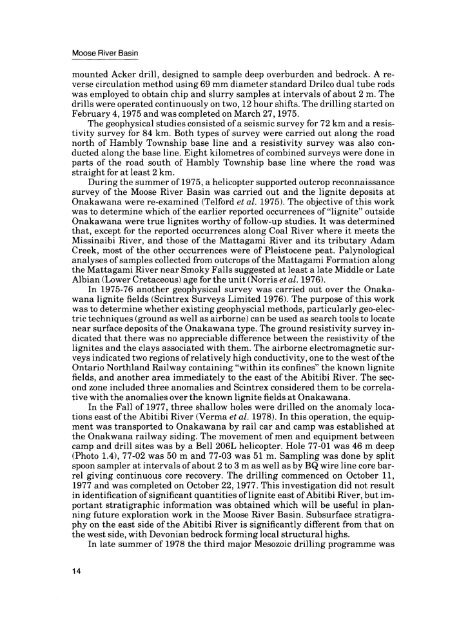Moose River Basin: geology and mineral potential - Geology Ontario
Moose River Basin: geology and mineral potential - Geology Ontario
Moose River Basin: geology and mineral potential - Geology Ontario
Create successful ePaper yourself
Turn your PDF publications into a flip-book with our unique Google optimized e-Paper software.
<strong>Moose</strong> <strong>River</strong> <strong>Basin</strong><br />
mounted Acker drill, designed to sample deep overburden <strong>and</strong> bedrock. A re<br />
verse circulation method using 69 mm diameter st<strong>and</strong>ard Drilco dual tube rods<br />
was employed to obtain chip <strong>and</strong> slurry samples at intervals of about 2 m. The<br />
drills were operated continuously on two, 12 hour shifts. The drilling started on<br />
February 4,1975 <strong>and</strong> was completed on March 27,1975.<br />
The geophysical studies consisted of a seismic survey for 72 km <strong>and</strong> a resis<br />
tivity survey for 84 km. Both types of survey were carried out along the road<br />
north of Hambly Township base line <strong>and</strong> a resistivity survey was also con<br />
ducted along the base line. Eight kilometres of combined surveys were done in<br />
parts of the road south of Hambly Township base line where the road was<br />
straight for at least 2 km.<br />
During the summer of 1975, a helicopter supported outcrop reconnaissance<br />
survey of the <strong>Moose</strong> <strong>River</strong> <strong>Basin</strong> was carried out <strong>and</strong> the lignite deposits at<br />
Onakawana were re-examined (Telford et al. 1975). The objective of this work<br />
was to determine which of the earlier reported occurrences of "lignite" outside<br />
Onakawana were true lignites worthy of follow-up studies. It was determined<br />
that, except for the reported occurrences along Coal <strong>River</strong> where it meets the<br />
Missinaibi <strong>River</strong>, <strong>and</strong> those of the Mattagami <strong>River</strong> <strong>and</strong> its tributary Adam<br />
Creek, most of the other occurrences were of Pleistocene peat. Palynological<br />
analyses of samples collected from outcrops of the Mattagami Formation along<br />
the Mattagami <strong>River</strong> near Smoky Falls suggested at least a late Middle or Late<br />
Albian (Lower Cretaceous) age for the unit (Norris et al. 1976).<br />
In 1975-76 another geophysical survey was carried out over the Onaka<br />
wana lignite fields (Scintrex Surveys Limited 1976). The purpose of this work<br />
was to determine whether existing geophyscial methods, particularly geo-electric<br />
techniques (ground as well as airborne) can be used as search tools to locate<br />
near surface deposits of the Onakawana type. The ground resistivity survey in<br />
dicated that there was no appreciable difference between the resistivity of the<br />
lignites <strong>and</strong> the clays associated with them. The airborne electromagnetic sur<br />
veys indicated two regions of relatively high conductivity, one to the west of the<br />
<strong>Ontario</strong> Northl<strong>and</strong> Railway containing "within its confines" the known lignite<br />
fields, <strong>and</strong> another area immediately to the east of the Abitibi <strong>River</strong>. The sec<br />
ond zone included three anomalies <strong>and</strong> Scintrex considered them to be correla<br />
tive with the anomalies over the known lignite fields at Onakawana.<br />
In the Fall of 1977, three shallow holes were drilled on the anomaly loca<br />
tions east of the Abitibi <strong>River</strong> (Verma et al. 1978). In this operation, the equip<br />
ment was transported to Onakawana by rail car <strong>and</strong> camp was established at<br />
the Onakwana railway siding. The movement of men <strong>and</strong> equipment between<br />
camp <strong>and</strong> drill sites was by a Bell 206L helicopter. Hole 77-01 was 46 m deep<br />
(Photo 1.4), 77-02 was 50 m <strong>and</strong> 77-03 was 51 m. Sampling was done by split<br />
spoon sampler at intervals of about 2 to 3 m as well as by BQ wire line core bar<br />
rel giving continuous core recovery. The drilling commenced on October 11,<br />
1977 <strong>and</strong> was completed on October 22, 1977. This investigation did not result<br />
in identification of significant quantities of lignite east of Abitibi <strong>River</strong>, but im<br />
portant stratigraphic information was obtained which will be useful in plan<br />
ning future exploration work in the <strong>Moose</strong> <strong>River</strong> <strong>Basin</strong>. Subsurface stratigra<br />
phy on the east side of the Abitibi <strong>River</strong> is significantly different from that on<br />
the west side, with Devonian bedrock forming local structural highs.<br />
In late summer of 1978 the third major Mesozoic drilling programme was<br />
14

















